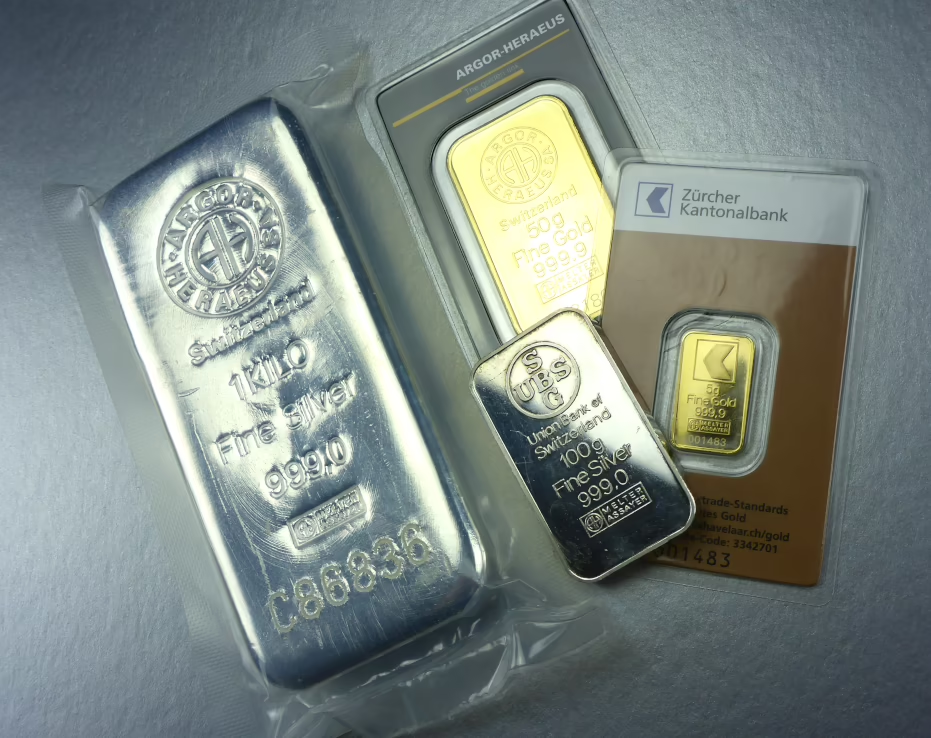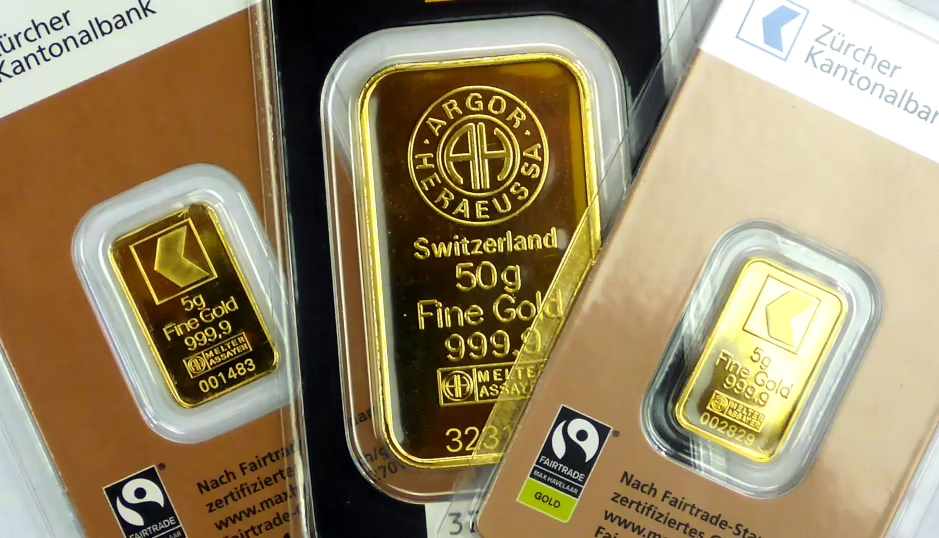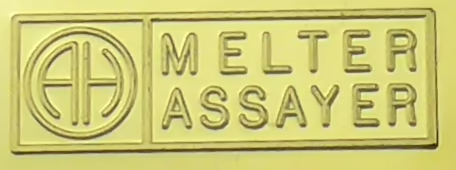Precious metal bars
Summary
-
Precious metal bars display various markings that provide accurate information about the precious metal.
-
In Switzerland, all bars must bear the fineness and the stamp of the smelter or assayer.
-
Gold and silver usually have the fineness 999.9 and 999.
-
Platinum and palladium usually have a fineness of 999.5.
-
The minimum fineness to be considered a bank precious metal is 995 for gold, 999 for silver, 999.5 for platinum and 999.5 for palladium.
-
Only bars from Swiss manufacturers or LBMA-certified refineries are VAT-exempt and may be imported into Switzerland by private individuals.
-
Switzerland is one of the most important trading centres and producing countries for precious metal bars.
What are precious metal bars
Precious metal bars are pieces of precious metal. Although the shape is usually a cuboid, round bars and other shapes are also possible. Standard bars represent a trapezoidal prism, their base and top are rectangular, but the top is smaller than the base. Easily distinguishable from these are coins and especially precious metal granules.
Precious metal ingots have existed since metalworking first began, and there are even known finds of bronze ingots from the Bronze Age. As a raw material for metal processing, bars offer the advantage that metals in this form can be easily transported and traded.

Important note: Disclaimer and riskThis blog post is intended solely for informational purposes and the critical assessment of facts. We would like to help you form your own opinion and better understand the financial markets. This text does not constitute investment advice!
|
Banking precious metals
Precious metal bars that have the necessary hallmarks and a certain minimum fineness are considered to be bank precious metals.
| Metal | Minimum fineness in thousandths |
|---|---|
| Gold | 995 |
| Silver | 999 |
| Platinum and palladium | 999,5 |
Hallmarks of precious metal bars
The Swiss Precious Metals Control Act prescribes various hallmarks on bars. Each hallmark has its own meaning and must therefore not be omitted. However, these hallmarks are also prescribed in other countries, both by the states and by standardisation organisations. The most important standardisation organisation for precious metals is the LBMA, London Bullion Market Association.
Logo of the manufacturer or dealer
Some dealers, such as major banks and cantonal banks, have their bars marked with their own logo by the manufacturer. However, the manufacturer can still be recognised by the prescribed manufacturer's

Country of manufacture
Sometimes the country of manufacture is also indicated on the bar, especially Swiss manufacturers like to stamp it on.
Weight
The weight of a bar is stamped on the commercial precious metal bars. Either the metric measure gram or the imperial measure ounce (oz) is used. Bars are available from one gram up to 12 kg for gold or 31 kg for silver.
The imprinted weight always refers to the pure precious metal in the bar. The bar is therefore slightly heavier than the imprinted weight.
Metal
The metal from which a bar is made is stamped on all commercially available bars. The English language is usually used for this: Fine Silver for fine silver, Fine Gold for fine gold, Palladium for palladium and Platinum for platinum.
Only gold and silver standard bars, which are used by funds, banks and national banks and are of little importance to private investors, are often not stamped with the metal.
Fineness / fineness
This hallmarking is prescribed by the Precious Metals Control Ordinance. The fineness of a bar indicates how pure the gold is. In the case of a 999 bar, 999 parts of 1000 are certainly pure precious metal. For gold and silver, the fineness of 999 and 999.9 is common today. For platinum and palladium, a fineness of 999.5 is the standard.
Manufacturer (smelter or assayer)
This stamp of the smelter or assayer is required by the Precious Metals Control Ordinance.
Each smelter or assayer has his own stamp. It usually consists of the company logo or a unique abbreviation and the words for smelter and/or assayer. The words melter and assayer are sometimes also in French or English Schmelzer = Fondeur = Melter and Prüfer = Essayeur = Assayer.
An overview of the stamps of Swiss precious metal melters and assayers is provided by the Federal Department of Finance as a PDF.

Serial number
For standard bars the serial number is prescribed by the LBMA, but today the serial number is also common for smaller bars. It is usually applied by means of laser engraving.
Year
The year of manufacture can be stamped on the bar, but it is only required by the LBMA for standard bars.
This information can be very helpful, for example, when dealing with bars from a country that has suddenly been sanctioned. In such cases, bars that were produced before the sanctioning are not affected by the sanctions.
Significance of hallmarks for trade and taxes
The reasons for the appearance and the hallmarks of precious metal bars lie, as so often, in the laws. In Switzerland, the Precious Metals Control Act and the Precious Metals Control Ordinance as well as the VAT Ordinance are responsible for this.
For gold to be VAT-exempt, it must meet the requirements of the VAT Ordinance, but this is the case for all gold traded by Swiss banks and dealers with private investors.
Importance of the LBMA for Swiss precious metals investors
Switzerland, which relies heavily on international trade, strives to ensure that its laws and regulations are in line with those of its trading partners. In international precious metals trading, the London Bullion Market Association is the most important standardisation organisation. For this reason, the legislator refers to this organisation in various laws and regulations. For example, the import of precious metals is only permitted if it comes either from a Swiss smelter or assayer or from a smelter or assayer certified by the LBMA.
Here is a selection of important manufacturers of bullion
| LBMA certified gold bar manufacturers | Country |
|---|---|
| Argor-Heraeus SA | Switzerland |
| Metalor Technologies SA | Switzerland |
| Pamp SA | Switzerland |
| Px Précinox SA | Switzerland |
| Valcambi S.A. | Switzerland |
| Agosi AG | Germany |
| Aurubis AG | Germany |
| C. Hafner GmbH + Co. KG | Germany |
| Heimerle + Meule GmbH | Germany |
| Umicore Sa Refining | Belgium |
| Beautiful Edelmetaal BV | Netherlands |
| Chimet S.p.A | Italy |
| Italpreziosi S.p.A | Italy |
| TCA S.p.A | Italy |
| Rand Refinery Ltd. | South Africa |
| Royal Canadian Mint | Canada |
| Kennecott Utah Copper LLC | USA |
| Western Australian / Perth Mint | Australia |
The only major Swiss manufacturer of gold bars that is not LBMA certified is Metalor Technologies SA of Biel.
Manufacture of precious metal bars
Precious metal bars can be produced in two ways Casting or stamping. Small bars are punched out of strands and then stamped. Larger bars, from 50 g, are cast. The required amount of gold or silver granulate is melted and then poured into a bar mould where the metal cools.
Precious metal bars, the basis of many investments
If you want to invest in gold or silver, you can do so in a wide variety of forms: jewellery, coins or bars - all forms have their advantages and thus their raison d'être, but precious metal bars are not the basic product for ETFs, gold savings plans and others for no reason. They have the advantage that they are standardised, easily tradable and have low production costs compared to coins or jewellery. This makes them the ideal asset for people who want to invest in the metal value.
Are standard bars suitable for private individuals?
Good delivery bars, also called standard bars, are defined by the LBMA and are mainly used by funds, banks, insurance companies and national banks because of their high value. Although the name would suggest otherwise, standard bars are not standardised in weight. Each bar has its own weight, for silver this is between 750 and 1100 ounces, which corresponds to 23 to 34 kg. For gold, the range of permissible weights goes from 350 to 430 ounces or 10.9 to 13.4 kg.
Due to the non-uniform weights, which do not even have to be imprinted, standard bars increase the cost of trading, which is reflected in the price paid for them. This and the large value of a single bar are the reasons why they are not recommended for private individuals.
Which precious metal bars should one buy?
There are many manufacturers of precious metal bars in different countries that produce bars stamped or cast with elaborate decorations or very simple.
Investors who buy gold and silver bars mainly want to earn from price increases of the precious metals, so it is important to buy bars that are as close as possible to the gold price. The rule of thumb is that the higher the weight of the individual bar, the lower the percentage premium on the precious metal price. However, which size one ultimately buys is an individual decision.
Another important aspect is the manufacturer of the bar. It should definitely come from a Swiss foundry or assayer or from an LBMA-certified refinery. Only these bars are exempt from VAT and only these refineries guarantee that the gold does not come from conflict or illegal mines.
Precious metal bars from Switzerland
Many people do not know that Switzerland is one of the precious metal trading centres of the world. This applies not only to virtual trade, but also to physical precious metals. Five of the world's largest precious metal refineries are located in Switzerland three in Ticino and two in western Switzerland.
The high importance of the gold trade is also reflected in the import statistics of Swiss customs, where precious metals account for up to one third. 60% of the world's annual production of gold is refined in Switzerland.
Trade precious metal bars on PreMeSec
Do you have gold, silver, platinum or palladium bars or would you like to buy them?
Sell and buy your precious metal bars on PreMeSec.ch!
Frequently asked questions about precious metal bars
What is a gold bar?
-
Gold bars are pieces of gold that are not coins. They must have at least the fineness stamped on them and bear the smelter's or assayer's stamp.
Are good delivery bars / standard bars suitable for private individuals?
-
Since standard silver bars cost close to twenty thousand francs and standard gold bars several hundred thousand francs, they are too expensive for most investors anyway. Even private individuals who have the necessary capital should not buy standard bars. Since standard bars are not standardised in terms of weight, trading with them means increased expense, this leads to greater discounts than 15 kg silver bars or 1 kg gold bars when they are resold.
What information is usually stamped on gold and silver bars?
-
Bars from Swiss production normally bear the following information:
-
Logo of the dealer or manufacturer
-
Country of manufacture
-
Weight
-
Metal
-
Fineness (mandatory)
-
Stamp of the smelter or assayer (mandatory)
-
Serial number
-
Year of production (rare)
-
I have been offered gold bars from Africa, should I buy them?
-
In Africa, only the Rand Refinery is LBMA certified and only their bars may be imported into Switzerland by private individuals. Anyone who buys bars from other sources in Africa runs the risk of being cheated or, even worse, finances wars with blood gold and is guilty of violating the Precious Metals Control Act.
Especially the very attractive prices partly up to 25 % below the precious metal price should be a warning that this is a fraud or gold from illegal sources.
